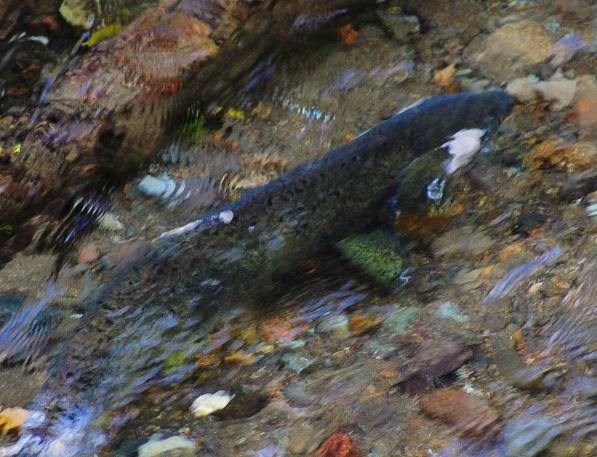2017 Week 19 Newsletter
Salmon in the River
The salmon have been appearing in the river over the last month and the Bald Eagles are back to snack on their favorite food. We love living so close to a salmon river (ask me again once they are "fertilizing" our fields during the winter floods). But, farming so close to the river also brings a sense of responsibility to take care of the river. Our farm motto includes the tagline "Sustaining the Land" - and this applies to the water, too. The farm sits at the confluence of two rivers, the North and South Forks of the Skokomish River, that are both salmon rivers. We choose to be certified organic not just to grow good food that is healthy for humans but also to farm in a way that treats the land with respect. Next year we also plan on applying to be certified Salmon Safe. Like the organic certification - it won't change much of what we are doing here at the farm. But, there is value in going through the inspection process to help remind us of good practices as well as identifying areas where we can improve. Some of the salmon friendly practices of our current farm plan include 74 acres placed in a conservation easement as a buffer with native plantings along the rivers as well as a 34 acre wetland easement at the confluence of the rivers.
Chinook Salmon in the North Fork of the Skokomish River
"I'm so glad I live in a world where there are Octobers."
-Anne of Green Gables
CSA Basket - Week 19
Your CSA basket this week includes the following veggies:
Howden Pumpkin - mainly bred for a carving pumpkin - but you can use it for baking or for the seeds if you like
Cucumbers - the favorites seem to be hanging on, add them to your salad or pickle some to keep longer
Bok Choi - a nice green for braising - sweet and creamy flavor
Rutabaga - These are a great potato substitute but have a unique flavor. They store in the fridge as long as potatoes do in the pantry.
Cabbage - smaller heads - some will get green and some purple
Purple Top Turnips - great for roasting or eating raw in slices
Beets - also good for roasting when diced into small cubes and tossed with olive oil and salt and pepper - then add feta cheese and use to dress a salad
Broccoli - the plants are still sending up tasty side shoots
Radishes - the return of a spring favorite
Carrots - A new variety - Dolciva, which are sweeter (frost may help too)
Ancho Peppers - not too hot - nice for adding a bit of heat to your dishes
Kale - see recipe for adding kale to a chili - a nice way to get more greens in your diet
Veggie of the Week:
Pumpkin!
Botanical Facts - Cucurbita is a genus of about 27 trailing and climbing species of annuals and perennials originating in North, South, and Central America. It is divided into two groups: gourds and pumpkins. Pumpkins are grown for both their edible and ornamental fruit.
Historical Origins and Culinary Uses - Cucurbita maxima, the principal parent of pumpkins, is native to South America, and seeds found in Peru have been dated to 1200 CE. Today many varieties are grown worldwide. The name "pumpkin" is thought to have come from the old French word pompon, which came from the Ancient Greek word pepon - the word for melons. Their use in cooking is extensive and they are popular in soups, stews, and roasted as well as in a wide variety of baked goods from pies to breads and muffins. The seeds of the pumpkin are also edible.
Chili with Kale and Ancho
It's starting to feel like soup and chili weather! Try this chili for the next Seahawks game!
Ingredients:
1 ancho chili pepper, seeds removed and finely minced (if you like more spice you can add a few seeds)
1 red, 1 yellow, and 1 green bell pepper, diced
1 yellow onion, diced
2 cloves garlic, minced
28-oz can fire-roasted diced tomatoes
1 15 oz can each: kidney, pinto, black beans
1 bunch kale, roughly chopped
1 Tbsp chili powder
1. In a large soup pot, add olive oil, peppers, onions, garlic, and kale. Kale stems can be removed and chopped separately from the leaves and then added and used like the onion. Sauté for 10 minutes until tender - stirring occasionally.
2. Add beans (drained and rinsed), chili powder, and tomatoes to the pot. Bring pot to a boil then reduce heat and simmer for 30 minutes. Season to taste with additional chili powder, salt and pepper.
3. Serve warm with toppings of scallions, cheese, and sour cream and a side of corn bread. Leftovers freeze well.
Woolly Bear
These cute little guys are everywhere on the farm this week - maybe you have seen them at your place, too? They are the larval form of Pyrrharctia isabella, the Isabella tiger moth. The Woolly Bear caterpillar has 13 distinct segments of either rusty brown or black. Do you know the legend of the woolly bear? According to the legend - the wider the rusty brown sections (or the more brown segments there are), the milder the coming winter will be. The more black there is, the more severe the winter.
I think he may be saying we are in for a less than mild winter. What do you think? The early frosts might be a harbinger of harder weather ahead, too?
One more week of Farmers Markets! We will be at the West Olympia and Harstine Island Farmer's Markets on Tuesday and Saturday this week! This is also the next to last CSA share of the season - but you can expect a monthly newsletter throughout the winter to let you know about happenings on the farm.
Don't forget to follow and like the farm on Facebook or Instagram! We appreciate your support!
Your SVF Farm Team




